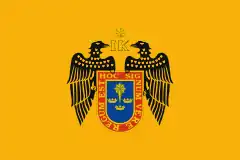 | |
| Location | Paseo de los Héroes Navales |
|---|---|
| Designer | Ismael Pozo Velit |
| Material | Bronze |
La yunta, also known as El trabajo or Los bueyes, is a bronze sculpture in the Paseo de los Héroes Navales, Lima, Peru.[1][2][3]
Description
The sculpture represents the moment in which a farmer works the land with two yoked oxen and a plough. It is an indigenous motif that was commissioned by the Chinese colony in Peru, together with the sculpture Las llamas by Agustín Rivera, as a gift to the city of Lima for the fourth centenary of the Spanish foundation of Lima.[4][5]
It was located on the Paseo de la República in 1937, although successive reforms of the place made it lose the pedestal.[1]
On April 24, 2018, the sculptures of the Paseo de los Héroes Navales, including Las Llamas, were declared the Cultural heritage of Peru by the Ministry of Culture.[6][7]
See also
References
- 1 2 "La yunta". Grupo de Estudio sobre Arte Público en Latinoamérica.
- ↑ Lavarello Vargas de Velaochaga, Gabriela (2009). Artistas plásticos en el Perú: siglos XVI - XVII - XVIII - XIX - XX (in Spanish). G. Lavarello Vargas de Velaochaga.
- ↑ "La histórica escultura "La Yunta" fue garabateada por extraños". América Noticias. 2015-01-26.
- ↑ Castrillón Vizcarra, Alfonso (1991). Escultura monumental y funeraria en Lima (in Spanish). Banco de Crédito del Perú.
- ↑ Chuhue, Richard (2017). Capón. El barrio chino de Lima (PDF) (in Spanish). Municipalidad Metropolitana de Lima. ISBN 9789972726156. OCLC 1126541508.
- ↑ "Resolución Viceministerial N.° 053-2018-VMPCIC-MC". Gob.pe. 2018-04-24.
- ↑ Bedoya Ramos, Daniel (2019-08-01). "La agonía del Paseo de los Héroes Navales: patrimonio sufre deterioro de monumentos". El Comercio.
